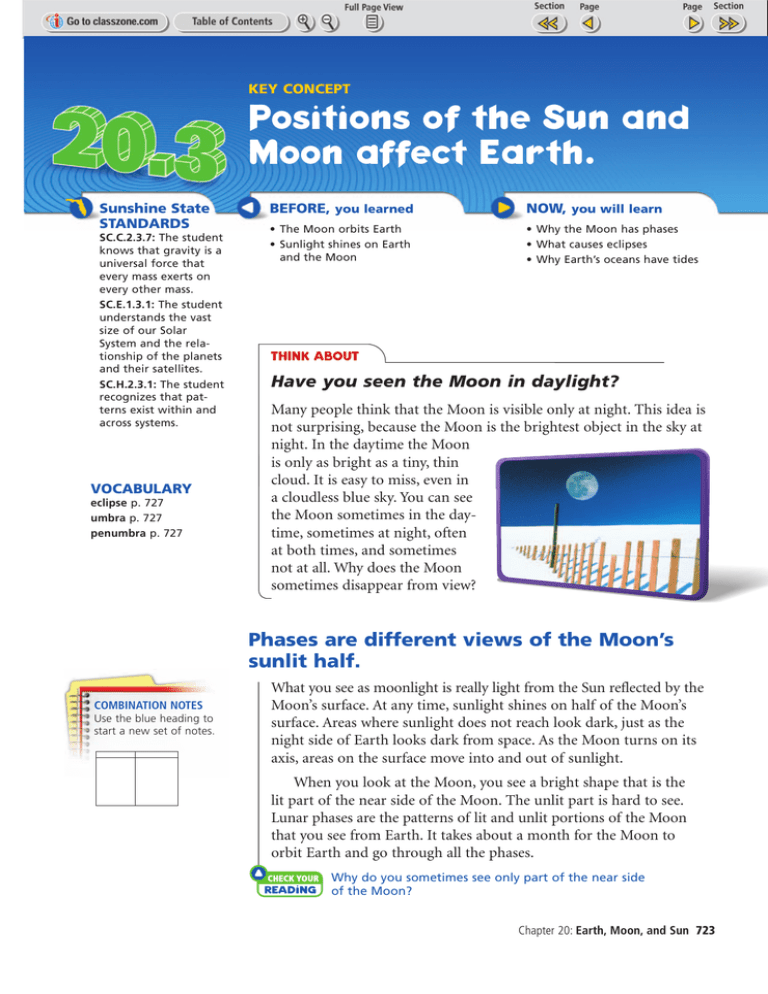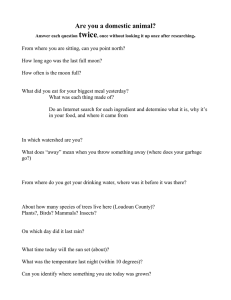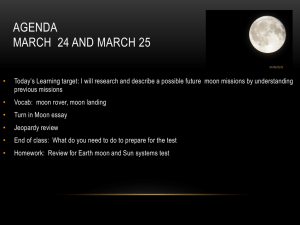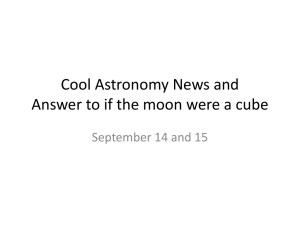Positions of the Sun and Moon affect Earth.
advertisement

KEY CONCEPT Positions of the Sun and Moon affect Earth. Sunshine State STANDARDS SC.C.2.3.7: The student knows that gravity is a universal force that every mass exerts on every other mass. SC.E.1.3.1: The student understands the vast size of our Solar System and the relationship of the planets and their satellites. SC.H.2.3.1: The student recognizes that patterns exist within and across systems. VOCABULARY eclipse p. 727 umbra p. 727 penumbra p. 727 BEFORE, you learned NOW, you will learn • The Moon orbits Earth • Sunlight shines on Earth and the Moon • Why the Moon has phases • What causes eclipses • Why Earth’s oceans have tides THINK ABOUT Have you seen the Moon in daylight? Many people think that the Moon is visible only at night. This idea is not surprising, because the Moon is the brightest object in the sky at night. In the daytime the Moon is only as bright as a tiny, thin cloud. It is easy to miss, even in a cloudless blue sky. You can see the Moon sometimes in the daytime, sometimes at night, often at both times, and sometimes not at all. Why does the Moon sometimes disappear from view? Phases are different views of the Moon’s sunlit half. COMBINATION NOTES Use the blue heading to start a new set of notes. What you see as moonlight is really light from the Sun reflected by the Moon’s surface. At any time, sunlight shines on half of the Moon’s surface. Areas where sunlight does not reach look dark, just as the night side of Earth looks dark from space. As the Moon turns on its axis, areas on the surface move into and out of sunlight. When you look at the Moon, you see a bright shape that is the lit part of the near side of the Moon. The unlit part is hard to see. Lunar phases are the patterns of lit and unlit portions of the Moon that you see from Earth. It takes about a month for the Moon to orbit Earth and go through all the phases. Check Your Reading Why do you sometimes see only part of the near side of the Moon? Chapter 20: Earth, Moon, and Sun 723 VISUALIZATION CLASSZONE.COM Explore lunar phases. reading tip Use the red dashed lines at each position in the diagram on page 725 to determine what part of the Moon is visible from Earth. The Moon’s position in its monthly orbit determines how it appears from Earth. The diagram on page 725 shows how the positions of the Moon, the Sun, and Earth affect the shapes you see in the sky. Waxing Moon First Week The cycle begins with a new moon. From Earth, the Moon and the Sun are in the same direction. If you face a new moon, you face the Sun. Your face and the far side of the Moon are in sunlight. The near side of the Moon is unlit, so you do not see it. During a new moon, there appears to be no Moon. As the Moon moves along its orbit, sunlight begins falling on the near side. You see a thin crescent shape. During the first week, the Moon keeps moving farther around, so more of the near side becomes lit. You see thicker crescents as the Moon waxes, or grows. When half of the near side of the Moon is in sunlight, the Moon has completed one-quarter of its cycle. The phase is called the first quarter, even though you might describe the shape as a halfmoon. You can see in the diagram that the Moon is 90 degrees—at a right angle—from the Sun. If you face the first-quarter moon when it is high in the sky, sunlight will shine on the right side of your head and the right side of the Moon. Second Week reading tip Crescent and gibbous describe the shape, while waxing and waning describe the changes— growing or shrinking. You see more of the Moon as it moves along its orbit during the second week. The phase is called gibbous (GIHB-uhs) when the near side is more than half lit but not fully lit. The Moon is still waxing, so the phases during the second week are called waxing gibbous moons. check your reading Why does the Moon sometimes seem to have a crescent shape? Waning Moon Third Week Halfway through its cycle, the whole near side of the Moon is in sunlight—a full moon. You might think of it as the second quarter. Viewed from Earth, the Moon and the Sun are in opposite directions. If you face a full moon at sunset, sunlight from behind you lights the back of your head and the near side of the Moon. As the Moon continues around during the third week, less and less of the near side is in sunlight. The Moon seems to shrink, or wane, so these phases are called waning gibbous moons. Fourth Week When the near side is again only half in sunlight, the Moon is three-quarters of the way through its cycle. The phase is called the third quarter. The Moon is again 90 degrees from the Sun. If you face the third-quarter moon when it is high in the sky, sunlight will shine on the left side of your head and the left side of the Moon. 724 Unit 6: Space Science Lunar Phases The appearance of the Moon depends on the positions of the Sun, Moon, and Earth. If you could watch the Moon from high above its pole, you would always see half the Moon in sunlight and half in darkness. View from Earth Viewed from Earth, the Moon’s shape seems to change. sunlight 1 ) new moon 1 (S K IN WA XI NG WA NI NG new moon ( G IN HR OW GR first week G IN first week ) waxing crescent 2 second week fourth week 2 first quarter 4 second week Earth lin eo waxing gibbous fs igh t Not to scale third week 3 third week 3 full moon full moon waning gibbous direction from Earth waning gibbous This lit portion is visible from Earth. 4 fourth week third quarter waning crescent COMPARE How are the sunlit portions alike in the image and the diagram of the waning gibbous moon? Chapter 20: Earth, Moon, and Sun 725 As the Moon continues to move around Earth during the fourth week, less and less of the near side is in sunlight. The waning crescent moon grows thinner and thinner. At the end of the fourth week, the near side is again unlit, and the new moon begins a new cycle. Crescent and Gibbous Moons Think through the waxing lunar phases again. The Moon waxes from new to crescent to gibbous during the first half of its cycle. Then it wanes from full to gibbous to crescent during the second half of its cycle. The amount of the Moon that you see from Earth depends on the angle between the Moon and the Sun. When this angle is small, you see only a small amount of the Moon. Crescent moons occur when the Moon appears close to the Sun in the sky. As a result, they are visible most often in the daytime or around the time of sunrise or sunset. When the angle between the Sun and the Moon is large, you see a large amount of the Moon. Gibbous and full moons appear far from the Sun in the sky. You may see them in the daytime, but you are more likely to notice them at night. check your reading What shape does the Moon appear to be when it is at a small angle to the Sun? Phases of the Moon Why does the Moon seem to change shape? SKILL FOCUS Making models PROCEDURE 1 Place the ball on the stick, which will act as a handle. The ball will represent the Moon, and your head will represent Earth. 2 Hold the ball toward the light, then move it to your left until you see a bright MATERIALS 3 Move the ball farther around until half of what you see is lit. Draw it. • foam ball • stick • lamp 4 Keep moving the ball around to your left until the side you see is fully lit, TIME edge. Draw what you see. then half lit, then lit only a little bit. Each time, face the ball and draw it. WHAT DO YOU THINK? • In step 2, which side of the ball was lit? Explain why. • How are your drawings like the photographs of the Moon’s phases? Label each drawing with the name of the corresponding lunar phase. CHALLENGE When the Moon is a crescent, sometimes you can dimly see the rest of the Moon if you look closely. Where might the light that makes the darker part of the Moon visible come from? 726 Unit 6: Space Science 20 minutes Shadows in space cause eclipses. Sunlight streams past Earth and the Moon, lighting one side of each body. Beyond each body is a long, thin cone of darkness where no sunlight reaches—a shadow in space. The two bodies are far apart, so they usually miss each other’s shadow as the Moon orbits Earth. However, if the Moon, the Sun, and Earth line up exactly, a shadow crosses Earth or the Moon. An eclipse occurs when a shadow makes the Sun or the Moon seem to grow dark. In a lunar eclipse, the Moon darkens. In a solar eclipse, the Sun seems to darken. VOCABULARY Remember to record vocabulary terms. Earth Sun Moon Not to scale umbra penumbra Lunar Eclipses The Moon becomes dark during a lunar eclipse because it passes through Earth’s shadow. There are two parts of Earth’s shadow, as you can see in the diagram above. The umbra is the darkest part. Around it is a spreading cone of lighter shadow called the penumbra. Just before a lunar eclipse, sunlight streaming past Earth produces a full moon. Then the Moon moves into Earth’s penumbra and becomes slightly less bright. As the Moon moves into the umbra, Earth’s dark shadow seems to creep across and cover the Moon. The entire Moon can be in darkness because the Moon is small enough to fit entirely within Earth’s umbra. After an hour or more, the Moon moves slowly back into the sunlight that is streaming past Earth. A total lunar eclipse occurs when the Moon passes completely into Earth’s umbra. If the Moon misses part or all of the umbra, part of the Moon stays light and the eclipse is called a partial lunar eclipse. Earth’s shadow The Moon starts getting dark on one side as it passes into Earth’s umbra. Even when the Moon is completely within Earth’s umbra, some red sunlight, bent by Earth’s atmosphere, may still reach the Moon. Chapter 20: Earth, Moon, and Sun 727 Solar Eclipses In a solar eclipse, the Sun seems to darken because the Moon’s shadow falls onto part of Earth. Imagine that you are in the path of a solar eclipse. At first, you see a normal day. You cannot see the dark Moon moving toward the Sun. Then part of the Sun seems to disappear as the Moon moves in front of it. You are in the Moon’s penumbra. After several hours of growing darkness, the Moon covers the Sun’s disk completely. The sky becomes as dark as night, and you may see constellations. In place of the Sun is a black disk—the new moon— surrounded by a pale glow. You are in the Moon’s umbra, the darkest part of the shadow, experiencing a total solar eclipse. After perhaps a minute, the Sun’s bright surface starts to appear again. umbra penumbra Sun Not to scale June 21, 2001, Eclipse Moon Earth A solar eclipse occurs when the Moon passes directly between Earth and the Sun. As you can see in the diagram above, the side of the Moon that faces Earth is unlit, so solar eclipses occur only during new moons. total eclipse If you could watch a solar eclipse from space, it might seem more like a lunar eclipse. You would see the Moon’s penumbra, with the dark umbra in the center, move across Earth’s daylight side. However, the Moon is smaller than Earth, so it casts a smaller shadow. As you can see in the diagram above, the Moon’s umbra covers only a fraction of Earth’s surface at a time. path of penumbra path of umbra In this time-lapse photograph, the Sun’s disk appears darker as the Moon passes in front. When the Moon is exactly in front of the Sun, the sky grows as dark as night. 728 Unit 6: Space Science Path of June 21, 2001, Eclipse Only locations along the thin central path of the shadow experience a total eclipse. Other locations experience a partial eclipse. Only locations in the path of the Moon’s shadow experience a solar eclipse. Some people travel thousands of miles to be in the thin path of the Moon’s umbra so that they can experience a total solar eclipse. Locations near the path of the umbra get an eclipse that is less than total. If only the penumbra moves over your location, you experience a partial solar eclipse. The Moon covers just part of the Sun. COMBINATION NOTES Remember to make notes about new ideas. Bright light from the Sun’s disk can damage your eyes if you look directly at it. The Sun is unsafe to look at even when the Moon covers most of the Sun’s disk. If you have the chance to experience a solar eclipse, use a safe method to view the Sun. Check Your Reading Where is the Moon during a solar eclipse? Find a way to remember the difference between the two types of eclipses. The Moon’s gravity causes tides on Earth. If you have spent time near an ocean, you may have experienced the usual pattern of tides. At first, you might see dry sand that slopes down to the ocean. Then, waves creep higher and higher onto the sand. The average water level rises slowly for about 6 hours. The highest level is called high tide. Then the water level slowly drops for about 6 hours. The lowest level is called low tide. Then the water level rises and falls again. The entire pattern—two high tides and two low tides—takes a little more than 24 hours. Check Your Reading In areas with tides, the water generally reaches its lowest level twice a day and its highest level twice a day. How many high tides do you expect per day? Tides occur because the Moon’s gravity changes the shape of Earth’s oceans. The Moon pulls on different parts of Earth with different amounts of force. It pulls hardest on the side of Earth nearest it, a little less hard on the center of Earth, and even less hard on the farthest side of Earth. If Earth were flexible, it would be pulled into a football shape. Earth’s crust is hard enough to resist being pulled into a different shape, but Earth’s oceans do change shape. Chapter 20: Earth, Moon, and Sun 729 Cause of Tides The Moon’s gravity changes the shape of Earth’s oceans. low tide high tide rotation of Earth Moon Not to scale RESOURCE CENTER CLASSZONE.COM Learn more about tides. FLORIDA Content Preview reminder Gravity is a force of attraction between objects. You’ll learn more about gravity in grade 8. The diagram above shows what would happen if Earth were covered with a thick layer of water. The Moon’s pull produces a bulge of thicker ocean water on the side of Earth nearest the Moon. Another bulge of water is produced on the side of Earth farthest from the Moon because the Moon pulls the center of Earth away from that side. The layer of water is thinnest in the middle, between the bulges. A location moves past different thicknesses of water as Earth turns on its axis. As a result, the water level there rises and falls. The thickest water produces the highest level, which is high tide. A quarter of a rotation—6 hours—later, the location has moved to the thinnest layer of water, or low tide. Another high tide and low tide complete the cycle. Because the Moon is orbiting while Earth is turning, the cycle takes a little longer than the 24 hours in a day. Check Your Reading Why does a cycle of tides take about 24 hours? KEY CONCEPTS CRITICAL THINKING 1. When the Moon is full, where is it in its orbit around Earth? 4. Apply If you were on the Moon’s near side during a new moon, how much of the side of Earth facing you would be sunlit? 2. Where is the Moon in its orbit at the time of a solar eclipse? 3. If it is high tide where you are, is the tide high or low on the side of Earth directly opposite you? 730 Unit 6: Space Science 5. Predict If Earth did not turn, how would the pattern of tides be affected? CHALLENGE 6. Predict Would we see lunar phases if the Moon did not rotate while it orbits Earth?




